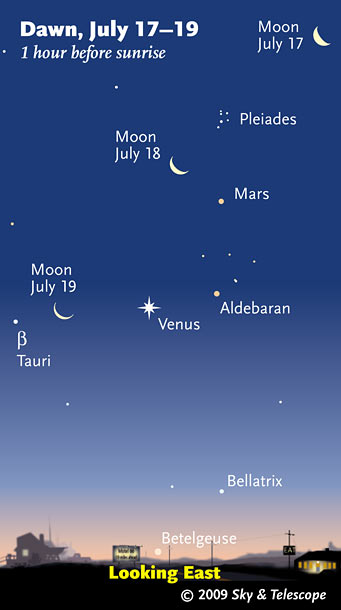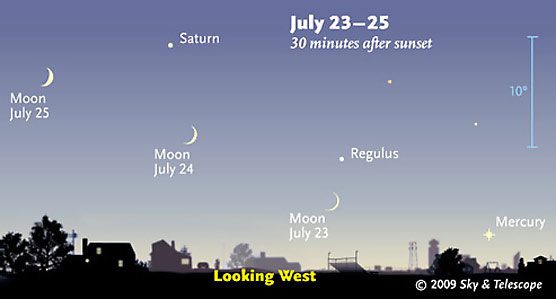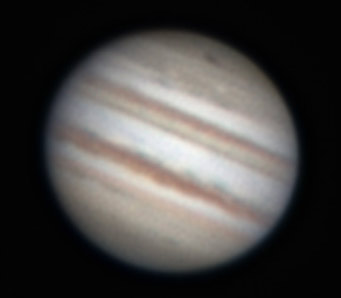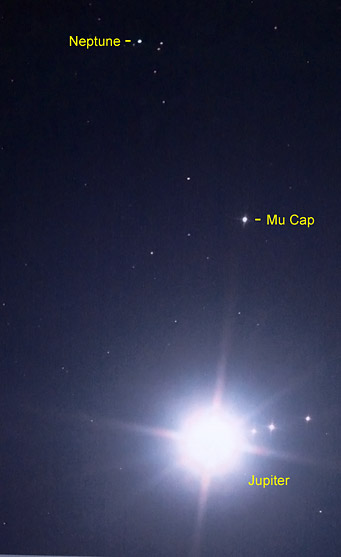Some daily events in the changing sky for July 17 – 25.

Late this week, the waning Moon passes Venus, Mars, and company in early dawn. (These scenes are drawn for the middle of North America. European observers: move each Moon symbol a quarter of the way toward the one for the previous date. In the Far East: move it halfway.)
Sky & Telescope diagram
Friday, July 17
Saturday, July 18
Sunday, July 19

NASA
Monday, July 20
Tuesday, July 21
Wednesday, July 22

Back in the evening sky, the Moon helps guide the way to Mercury, Regulus, and Saturn. The blue 10° scale is about the size of your fist held at arm's length.
Sky & Telescope diagram
Thursday, July 23
Friday, July 24
Saturday, July 25
Want to become a better amateur astronomer? Learn your way around the constellations. They're the key to locating everything fainter and deeper to hunt with binoculars or a telescope. For an easy-to-use constellation guide covering the whole evening sky, use the big monthly map in each issue of Sky & Telescope, the essential magazine of astronomy. Or download our free Getting Started in Astronomy booklet (which only has bimonthly maps).
Sky Atlas 2000.0 (the color Deluxe Edition is shown here) plots 81,312 stars to magnitude 8.5. That includes most of the stars that you can see in a good finderscope, and typically one or two stars that will fall within a 50× telescope's field of view wherever you point. About 2,700 deep-sky objects to hunt are plotted among the stars.
Alan MacRobert
Once you get a telescope, to put it to good use you'll need a detailed, large-scale sky atlas (set of charts; the standards are Sky Atlas 2000.0 or the smaller Pocket Sky Atlas) and good deep-sky guidebooks (such as Sky Atlas 2000.0 Companion by Strong and Sinnott, the more detailed and descriptive Night Sky Observer's Guide by Kepple and Sanner, or the classic Burnham's Celestial Handbook). Read how to use them effectively.
Can a computerized telescope take their place? I don't think so — not for beginners, anyway, and especially not on a telescope mount that is less than rigid and top-quality mechanically. As Terence Dickinson and Alan Dyer say in their Backyard Astronomer's Guide, "A full appreciation of the universe cannot come without developing the skills to find things in the sky and understanding how the sky works. This knowledge comes only by spending time under the stars with star maps in hand and a curious mind." Without these, "the sky never becomes a friendly place."
More beginners' tips: "How to Start Right in Astronomy".
This Week's Planet Roundup

The new Jupiter impact scar is the dark mark in the planet's South Polar Region (near top). "Here is the spot recorded in marginal seeing," writes S&T's Sean Walker. "It appears to be spreading out as predicted." The shot was made with a 14.5-inch reflector and stacked video at 3:46 UT July 21, 2009.
The mark is near System II longitude 210°. To find the times of its future central-meridian crossings, add 2 hours and 6 minutes to our listed times of the Great Red Spot's transits.
S&T: Sean Walker
Mercury is hidden deep in the glow of sunset.
Venus and Mars (magnitudes –4.1 and +1.1, respectively) are in the east during dawn. Venus is a dazzler; Mars, to Venus's upper right, is 120 times fainter. They're moving farther apart: from 10° to 13° separation this week.
Aldebaran, similar to Mars in both brightness and color, twinkles to the right of the line between the two planets. Above Mars are the Pleiades. Far left of the whole group shines bright Capella.
Jupiter (magnitude –2.8, in Capricornus) rises by the end of twilight and shines highest in the south in the early-morning hours.
Impact on Jupiter! A black dust scar like those of the Comet Shoemaker-Levy 9 impacts in 1994 has suddenly appeared in Jupiter's south polar region. See our article.
Saturn (magnitude +1.1, in Leo) is getting low in the west after dusk. Look early! In a telescope Saturn's rings are narrowing, appearing only 2½° from edge on. And they're getting very dim. The rings will turn edge-on to the Sun and go black on August 10th. They'll turn edge-on to Earth on September 4th, but by then Saturn will be lost in the sunset.
Uranus (magnitude 5.8, in Pisces), is high in the south before dawn.

On the morning of July 9th, Bob Kimmel of Rockledge, Florida, took this image of Jupiter (overexposed) and Neptune when they were 1/2° apart. Why are they so different in brightness? Jupiter is a bigger planet, but mostly it's because Jupiter is closer to the Sun (so it gets lit more brightly) and closer to Earth.
Kimmel used an 8-inch f/5 Newtonian reflector with a Canon D20a DSLR camera body on his back patio. This is an unguided 20-second exposure at ISO 3200.
Bob Kimmel
Neptune (magnitude 7.8, in Capricornus) remains only about 1° from Jupiter — but it's 17,000 times fainter, as shown here. See our finder charts for Uranus and Neptune, good for the rest of this year.
Both of these outermost planets show a very pale blue-green tint in a medium-size to large telescope, if your eye is particularly sensitive to color. Otherwise, or in a smaller telescope, they're basically gray.
Pluto (14th magnitude, in northwestern Sagittarius) is at its highest in the south during evening. If you've got a big scope and a dark sky, you can take on the Pluto challenge using the finder chart in the June Sky & Telescope, page 53.
All descriptions that relate to your horizon or zenith — including the words up, down, right, and left — are written for the world's mid-northern latitudes. Descriptions that also depend on longitude (mainly Moon positions) are for North America. Eastern Daylight Time (EDT) equals Universal Time (also known as UT, UTC, or GMT) minus 4 hours.
"Science is built up of facts, as a house is with stones. But a collection of facts is no more a science than a heap of stones is a house."
— Henri Poincaré (1854–1912)
To be sure to get the current Sky at a Glance, bookmark this URL:
http://SkyandTelescope.com/observing/ataglance?1=1
If pictures fail to load, refresh the page. If they still fail to load, change the 1 at the end of the URL to any other character and try again.
 0
0
Comments
You must be logged in to post a comment.